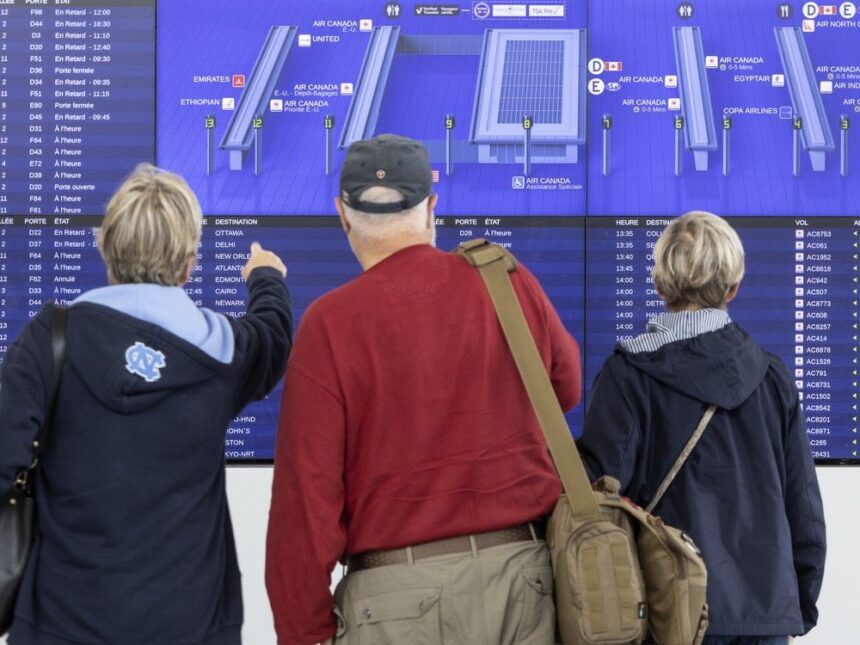As I arrived at Toronto Pearson’s Terminal 1 this morning, the scene was painfully familiar to anyone who’s traveled through Canada’s largest airport during a disruption. Lines snaked through the departures hall while airline staff, armed with clipboards and paper boarding passes, attempted to process travelers the old-fashioned way.
“We’ve been standing here for nearly two hours,” said Mariam Chowdhury, clutching her phone showing a flight to Montreal departing in 45 minutes. “Nobody seems to know what’s happening.”
What’s happening is Pearson’s second major technical failure this year. A significant network outage has crippled check-in systems across multiple airlines, forcing manual processing that’s creating cascading delays throughout the airport. According to the Greater Toronto Airports Authority (GTAA), the outage began around 5:30 a.m., affecting primarily Terminal 1 operations.
The disruption comes at a particularly bad time as summer travel season ramps up. Transport Canada data shows Pearson handled over 3 million passengers last June, with this year’s numbers expected to exceed pre-pandemic levels.
“We’re experiencing technical difficulties with our network systems affecting some check-in functions,” acknowledged GTAA spokesperson Beverly MacDonald in a statement. “Our IT teams are working to restore services as quickly as possible. We apologize for any inconvenience and thank passengers for their patience.”
Air Canada, the airport’s largest carrier, confirmed the impact extends beyond their check-in counters. “The network outage is affecting multiple carriers and airport services,” said Peter Fitzpatrick, Air Canada’s media relations director. “We’re implementing contingency measures but advise passengers to check their flight status before heading to the airport.”
On the ground, the human cost of the technical failure is evident. Families with young children sitting on suitcases. Business travelers anxiously checking watches. Airport staff looking increasingly frazzled as the morning progresses.
This isn’t Pearson’s first brush with technical problems this year. In February, a software glitch in the customs processing system created similar backlogs. And who could forget last summer’s baggage system failures that left thousands of travelers separated from their luggage for days?
The recurring issues raise questions about infrastructure investment at what should be Canada’s premier gateway. While the federal government announced $142 million in airport improvement funding last year, critics argue it’s not enough to address fundamental technical vulnerabilities.
“When you’re running critical transportation infrastructure, redundancy isn’t optional—it’s essential,” explains Dr. Anita Singh, transportation systems expert at Ryerson University. “Backup systems should engage seamlessly when primary networks fail. Today’s situation suggests that’s not happening.”
For smaller carriers operating at Pearson, the impact is particularly severe. Porter Airlines, which recently expanded operations at the airport, reported that staff were processing passengers manually but warned of potential cancellations if systems weren’t restored by afternoon.
Concession operators are feeling the pinch too. “We staffed up for a busy day, but with so many delayed flights, people aren’t even making it past security to reach the restaurants,” said Alex Rodriguez, manager at a Terminal 1 café. “This hurts everyone’s bottom line.”
Outside the airport, rideshare drivers circled endlessly, their apps showing request after request from stranded passengers. “I’ve never seen so many people trying to bail on their flights,” said Uber driver Harpreet Gill. “Some are asking to go to Billy Bishop to try catching alternative flights.”
The GTAA hasn’t provided an estimated timeline for restoration of services, but internal sources speaking on condition of anonymity suggest the problem involves both network hardware and security systems. “It’s not just a matter of resetting routers,” my source explained. “There are concerns about data integrity that complicate the recovery.”
For Pearson, which has worked to rebuild its reputation after pandemic-era challenges, today’s failure couldn’t come at a worse time. J.D. Power’s 2023 North American Airport Satisfaction Study showed Pearson improving but still ranking below average among large airports. Incidents like today’s threaten that progress.
As noon approached, there were signs of partial system recovery. Some airlines reported their check-in kiosks coming back online, though baggage systems remained problematic. The airport’s website, which had been intermittently accessible throughout the morning, stabilized with a prominent alert about the ongoing situation.
For passengers like the Sanderson family, bound for Florida, the technical explanation matters less than the practical outcome. “We saved for this vacation for two years,” said mother of three Jennifer Sanderson. “Now we’re not sure if we’ll even get there today. The kids are devastated.”
Airport officials are advising passengers with flights today to arrive at least three hours before departure and to check with their airlines before coming to the airport. Many carriers are offering fee waivers for those wishing to rebook.
As I headed out, I passed a group of arriving international travelers, blissfully unaware of the chaos that awaited them. It was a stark reminder that in our interconnected world, we’re all just one network outage away from returning to the paper-and-pencil era—especially, it seems, at Canada’s busiest airport.






